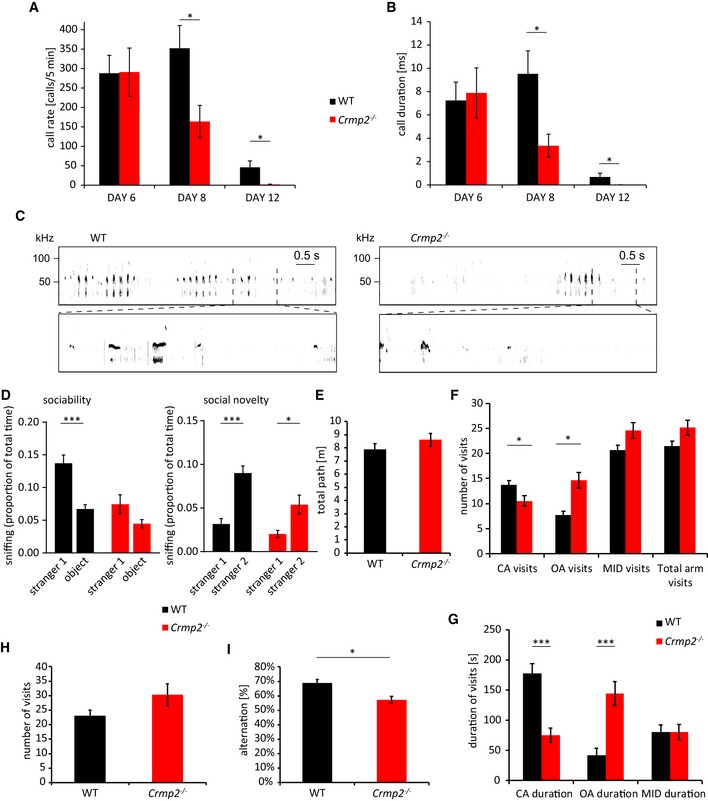-
A, B
Ultrasonic vocalization was measured at P6, P8, and P12 (WT n = 14 pups, crmp2
−/−
n = 13 pups). In crmp2
−/− mice, there is a significant decrease in the rate and duration of calls at P8 (call rate, WT 352 ± 58/5 min, crmp2
−/− 164 ± 41/5 min, P = 0.015; call duration, WT 9.52 ± 2 ms, crmp2
−/− 3.36 ± 1 ms, P = 0.011) and P12 (call rate, WT 46 ± 16/5 min crmp2
−/− 1.54 ± 1.24/5 min, P = 0.002; call duration, WT 0.68 ± 0.35 ms, crmp2
−/− 0.007 ± 0.006 ms, P = 0.002). Mean ± SEM, *P < 0.05, t‐test (P6, P8), Mann–Whitney test (P12).
-
C
Representative sonograms of the P8 mice.
-
D
3‐chamber test (WT n = 11 mice, crmp2
−/−
n = 13 mice). In sociability phase, WT mice spent significantly more time with a social partner (stranger 1), unlike knockouts [WT—stranger 1: 0.14 ± 0.01, object: 0.07 ± 0.007 (P = 0.0001); crmp2
−/−—stranger 1: 0.07 ± 0.01, object: 0.04 ± 0.006 (P = 0.07)]. In social novelty phase, when an object was substituted with a second social partner (stranger 2), both WTs and knockouts preferred novel mice to known mice [WT—stranger 1: 0.03 ± 0.006, stranger 2: 0.09 ± 0.008 (P < 0.0001); crmp2
−/−—stranger 1: 0.02 ± 0.004, stranger 2: 0.05 ± 0.01 (P = 0.02)]. Mean ± SEM, *P < 0.05, ***P < 0.001, t‐test.
-
E–G
Elevated plus maze test (n = 10 mice/genotype). (E) Total distance walked is similar in WT and crmp2
−/− (WT 7.9 ± 0.45 m, crmp2
−/− 8.6 ± 0.5 m, P = 0.3). (F) Frequency and (G) duration of open arm (OA) visits are increased in crmp2
−/− mice suggesting decreased anxiety. CA denotes closed arms, MID denotes the transition zone between arms, and total arm visits represent a sum of visits in all four arms. (CA frequency: WT 13.7 ± 0.9/5 min, crmp2
−/− 10.5 ± 1.1/5 min, P = 0.04; OA frequency: WT 7.7 ± 0.8/5 min, crmp2
−/− 14.6 ± 1.7/5 min, P = 0.002; MID frequency: WT 20.6 ± 1/5 min, crmp2
−/− 24.6 ± 1.6/5 min, P = 0.06; total arm visits: WT 21.4 ± 1/5 min, crmp2
−/− 25.1 ± 1.5/5 min, P = 0.07; CA duration: WT 177 ± 17 s, crmp2
−/− 75.3 ± 12.6 s, P < 0.001; OA duration: WT 42 ± 12.6 s, crmp2
−/− 144.4 ± 21 s, P < 0.001; MID duration: WT 80.26 ± 11.5 s, crmp2
−/− 80.17 ± 12.6 s, P = 0.99), mean ± SEM, *P < 0.05, ***P < 0.001, t‐test.
-
H, I
Y‐maze test (WT n = 9 mice, crmp2
−/−
n = 8 mice). Decreased alternations between arms of the maze indicate impaired working memory (number of visits, WT: 23.1 ± 1.9, crmp2
−/− 30.4 ± 3.8, P = 0.12; alternations, WT 68.8 ± 2.5%, crmp2
−/− 57.3 ± 2.5%, P = 0.006), mean ± SEM, *P < 0.05, t‐test.

